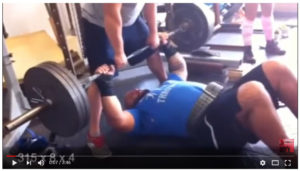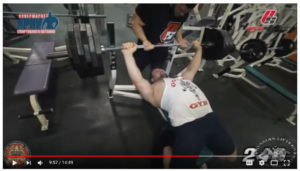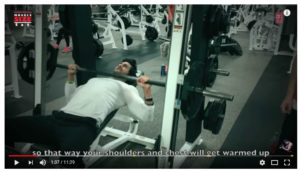Progress vs. Performance
It is apparent to me that many lifters confuse performance with progress. I understand this confusion because I was confused by this for years. I thought the only way to make progress was to perform your absolute best in every workout. I don’t think this way anymore.
A Performance Mindset
A performance mindset is based on doing the best that you can do today. A progress mindset is much more concerned about how today’s workout will contribute to your next workout; and not just the next workout, but how each workout will continue to affect the workouts that come after them. Many people assume as I once did that if you push yourself to do your very best today, that it will help you to be even better in your next workout. I learned that this assumption leads to a dead end road.
A Progress Mindset
A progress mindset is much more concerned about long term improvement than today’s performance. If you want to keep on improving, always leave something in reserve for the next workout. I highly recommend that you listen to Ed Coan who is one of the greatest powerlifting champions of all time, and listen to Mr. Universe, Bill Pearl, in the following videos:
Ed Coan
Bill Pearl
Get better at what you do before doing more
My belief is that if you want to keep on improving, you should feel like you are getting better at what you are already doing before you add on and do more. If you are getting better at lifting a specific amount of weight, the weight is going to get easier to lift. I like to let the weight become just as easy to lift as it was the last time it became easy enough to add weight. If I increase from 200 pounds to 205 pounds, I am going to keep using 205 pounds until it becomes as easy to lift as 200 pounds was before I increased to 205. I am then going to increase to 210 pounds and keep using 210 until it becomes as easy as 205 pounds was before I increased to 210. If I keep increasing in this manner over the course of a year to the point where I am using 250 pounds, it should feel just as easy to lift 250 pounds as it did to lift 200 pounds a year earlier.
Controlled Effort
Inner drive, enthusiasm, and motivation can be your best friends when it comes to pushing yourself with maximum effort. Max effort often works when the goal is short term progress or performance. At the same time, inner drive, enthusiasm, and motivation can become your enemies if you don’t learn to tame them with controlled effort when the goal is long term progress. This is why I recommend the use of training thresholds which I also refer to as precision points, as these help you to avoid exceeding your capacity for strong reps, strong sets, and a strong lifting motion.
Training Thresholds and Precision Points
Thresholds are based on your ability to repeat reps as long as you can maintain the same rep pace and rep speed from one rep to the next. Stop a set if your rep speed and rep pace start to slow down. Only repeat sets for a muscle group as long as the muscle group can recover back to full strength between sets. Stop doing sets for a muscle group if you reach a set where you are no longer recovering back to full strength. Only use weights that allow you to perform a smooth nonstop lifting motion and avoid weights that are so heavy that they cause a rep to slow down, pause, or stall in mid motion. These guidelines are not based on helping you to perform to your absolute limit in a given workout, rather they are based helping you to make progress in future workouts. But just remember this, training for progress may seem to short circuit your performance today, but the payoff is that it helps you to perform better in the future. Best of training to you.
Belt Squats: A Great Exercise
If you ever reach a point where you can’t do regular barbell back squats because of a back injury, you may find that belt squats are a good alternative. Belt squats provide an excellent way to give your legs a great workout without stressing your spinal column. Even if you don’t have a back injury and you just want to add some variety to your leg workouts, belt squats are a great leg exercise.
Different Variations of Belt Squats
There are several variations of belt squats both in terms of form and it in terms of equipment. Since Louie Simmons and Max Aita both coach elite lifters, and they are both advocates of including belt squats within leg workouts, I will start with some videos which are based on their instructions first.
Louie favors the wide stance squat, both for barbell squatting and for belt squats. Watch his instructions on how to do belt squats.
Louis Simmons coaching belt squats
Max Aita Coaching Belt Squats
You need a special machine to do Louie’s version of belt squats, but in the following video, Max Aita has one of his students doing belt squats without the use of a machine. Max prefers a little bit narrower stance, and instead of having his students sit back with their weight on their heals in order to emphasize the development of hips and glutes, Max coaches his student to allow their knees to track forward over their feet in order to develop the quads.
Here is another belt squat set up in which the chain from the belt goes through an opening of a couple of barbell plates:
A final option is to use belt squats in conjunction with a bar as shown on the video. Some lifters call these landmine belt squats.
If you need a belt for belt squats, you can find them online, however, you may find that some of the belts cut into your hips and thighs. The belt in the following video is designed to prevent this.
As with any exercise, I believe that the key to consistent progress is to push hard enough without pushing too hard. You can do this by repeating reps as long as you can maintain the same rep pace throughout the set. If your rep pace starts to slow down do to fatigue, stop the set. Repeat sets for a muscle group as long as the muscle group is at full strength and stop when you can no longer recover back to full strength from one set to the next. Follow these guidelines on a regular basis and you will be able to gradually add more and more weight to your lifts for a long time. Best of training to you.
How To Program Your Body To Gain Strength
 The main reason that most people choose a specific training method is that they hope it will lead to progress. When it comes to progress, you can either push yourself to make progress, or you can program yourself to make progress. Pushing yourself to make progress is based on constantly going all out in order to outdo your previous best. In contrast, programming yourself to make progress is based on repeating workouts that are done using a sufficient amount of effort, but not a maximum amount of effort. The goal is then to gradually increase the weight without experiencing an increase in effort. The last two sentences are very important. Just to make sure you did not overlook them, I am going to repeat them as a single paragraph that you should carefully read:
The main reason that most people choose a specific training method is that they hope it will lead to progress. When it comes to progress, you can either push yourself to make progress, or you can program yourself to make progress. Pushing yourself to make progress is based on constantly going all out in order to outdo your previous best. In contrast, programming yourself to make progress is based on repeating workouts that are done using a sufficient amount of effort, but not a maximum amount of effort. The goal is then to gradually increase the weight without experiencing an increase in effort. The last two sentences are very important. Just to make sure you did not overlook them, I am going to repeat them as a single paragraph that you should carefully read:
Programming yourself to make progress is based on repeating workouts that are done using a sufficient amount of effort, but not a maximum amount of effort. The goal is then to gradually increase the weight without experiencing an increase in effort.
The only way you can increase weight without increasing the effort is to gain strength. In order to explain this, an example is needed.
Effort on A Scale of 1 to 10
We’ll imagine that the amount of effort that it takes you to lift 100 pounds for ten reps can be rated on a scale of 1 to 10 with one being the least amount of effort, and ten being maximum effort. We’ll also assume that the amount of effort that it takes you to lift 100 pounds for ten reps is an eight. This means that even though you stop at ten reps, you can do an additional two or three reps if you pushed yourself to max effort. In order to program your body to work at an effort level of eight, your goal is to lift 100 pounds for ten reps for as many sets per workout as possible without the sets becoming harder than an eight. The more workouts and the more times you lift 100 pounds for ten reps at an effort level of eight, the more you are going to program those conditions into your body.
Don’t Make This Mistake
It would be a mistake to keep repeating sets of ten reps with 100 pounds if you reach a point where it starts to get harder and it takes an effort level of nine or ten to complete the lifts. Doing this would program your body to lift 100 pounds for ten reps at a more difficult level of effort. You don’t want to teach your body that it must struggle to lift 100 pounds.
Goal: More Weight; Not More Effort. Stay at an 8
If you program your body to function at an effort level of eight, and you raise the weight from 100 pounds to 105 pounds, your body is going to want to keep lifting at an effort level of eight instead of a nine. Your body does not want the added weight to become harder to lift, so it is going to gain some strength in order to make it just as easy to lift 105 pounds for ten reps as it was to lift 100 pounds for ten reps. If you add five pounds every month, but your body keeps gaining strength so that you can keep lifting the added weight at an effort level of eight, then you will be using 160 pounds by the end of the year at an effort level of eight.
Program for Long Term Progress
In the beginning stages of training, pushing yourself with maximum effort to gain strength may work really well, but there often comes a point when it causes burn out. At that point, programming your body for strength will often bring more consistent gains than pushing for strength. I personally believe that programming your body to function at an effort level of a 7 or 8 is a more effective method for achieving long term progress than constantly pushing to an effort level of ten with max effort.
From what I understand, Ed Coan is an example of a lifter who programmed his body for strength by using a reasonable amount of effort instead of pushing with max effort to keep getting stronger. Ed generally used a fourteen week training cycle and would then repeat the same cycle with an additional five pounds on all his lifts. He was able to do this by planning a whole cycle according to weights that he knew he could already lift. Ed knew he wouldn’t miss any lifts because he never planned to do a set or a lift that required max effort, he only practiced success and never pushed to the point of risking failure. This enabled Ed to gain just enough strength to add five additional pounds to each fourteen week cycle, but the key is that the cycles would never seem to get harder. From one cycle to the next, the weight would gradually increase, but the current fourteen week cycle would never feel harder than the last fourteen week cycle; each cycle would feel the same in terms of the amount of effort.
Programming Will Work for You
Ed says he never really maxed out. This means he probably finished each fourteen week cycle at an effort level of an eight or nine. When Ed finished a cycle with an 805 pound squat, it felt the same as when he finished the last cycle with an 800 pound squat. By the end of the year he would be doing 825 pounds which required the same amount of effort that 805 pounds did at the start of the year. After five years he would finish with 900 pounds which took the same amount of effort that 800 pounds took five years earlier. This is the idea behind programming your body to want to gain strength. The strategy worked and Ed never missed a lift in his workouts. It worked for him and it will work for you if you will be patient, disciplined, and learn how to program your body correctly. Best of training to you.
Hardgainers and Skinny Ectomorphs
 I recently listened to another expert on body types. I learned once again that ectomorphs are skinny and they can’t gain weight because they have a fast metabolism. They need to eat, eat, eat, and get plenty of carbs. No cardio, and they should stay away from any exercise that burns a lot of calories. If you are an ecto, make sure to stick with heavy weights and low reps during your weight training workouts. This is typical advice for ectomorphic skinny hardgainers. In the past, I believed the experts, and I still believe them, but I think they are grossly oversimplifying the classification of an ectomorphic skinny hardgainer.
I recently listened to another expert on body types. I learned once again that ectomorphs are skinny and they can’t gain weight because they have a fast metabolism. They need to eat, eat, eat, and get plenty of carbs. No cardio, and they should stay away from any exercise that burns a lot of calories. If you are an ecto, make sure to stick with heavy weights and low reps during your weight training workouts. This is typical advice for ectomorphic skinny hardgainers. In the past, I believed the experts, and I still believe them, but I think they are grossly oversimplifying the classification of an ectomorphic skinny hardgainer.
An Incorrect Assumption
It is assumed that skinny ectomorphs have a fast metabolism. I once held this assumption because it seemed to be such a common belief that it was hard to question. It still seems to be a common belief, but I don’t believe it any more. Why? Because I am basically a skinny ectomorphic hardgainer with a slow metabolism, not a fast metabolism, but a slow metabolism. Most people assume that if you have a slow metabolism, you will not be skinny, but it is not uncommon for a person with a light framed skinny body type to be the way they are because of an intolerance for extra calories. Without extra calories, you don’t gain weight, which means that if you are skinny to start with, you will stay skinny. In other words, there are skinny hardgainers who are skinny because they don’t eat much. In most people’s minds, this problem is super simple to fix; you simply start eating more. Unfortunately, it backfires by overloading a digestive system that is terrible at processing food. Undigested food does not help you gain muscle, it just makes you miserable and causes all kinds of digestive problems that most people can’t imagine if they have never had those problems.
Nonsense
The only person whom I have ever heard that had a different view point on how skinny ectomorphs should eat and train is Vince Gironda. I still can’t believe that decades have passed and he is the only one that I know of who has caught on to the problems that some ectomorphs face. Vince trained thousands of people; thousands. His experience with ectomorphs is that they would lose weight when they overate; yes, you read that right, they would lose weight when they ate big meals because it would screw up their digestion to no end. He also thought the common advice that skinny ectomorphs should work each muscle group only once or twice per week was nonsense. Vince thought that ectomorphs should work their whole body every day, five days per week with short workouts that were hard enough without being too hard. I personally tend to believe Vince because after trying all of the nonsensical falderal and poppycock that is commonly advised for ectomorphs, Vince’s advice proved to be better for me than anyone else’s.
The Stereotypical Ectomorph
Before I completely condemn all of the common advice for ectomorphs, it’s hard not to admit that there are many ectomorphs that can eat 5,000 or more calories per day without any digestive problems at all and they will still stay skinny, but this is only one type of skinny ectomorph, and it happens to be the stereotype. This is not true of every ectomorph. I know that there are skinny ectomorphic types that should not train each muscle group frequently and they are better off training each muscle group once or twice per week with high intensity training. There is no denying that some of these ectos will experience phenomenal gains with super high calorie diets and low frequency- high intensity training, but this is only one type of ectomorph, just one.
If you are an ectomorphic skinny guy that hates high calorie diets because you feel like you are going to explode, then you need to get out there and move every day and keep moving throughout the day. Won’t that burn off too many calories? Yes it will if you already have a super-fast metabolism, but if you are skinny because you don’t tolerate calories due to a slow metabolism, then you need to exercise a lot, and keep on exercising a lot so that your metabolism speeds up enough to stimulate a healthy appetite. Your tolerance for calories must increase to the point where you can take in more calories than you burn off.
All of my best gains in muscle have come when I have stayed active throughout the day and worked my whole body often. The once in a while workout plan while sitting around and stuffing yourself the rest of the time has never worked for my skinny ectomorphic body and is the worst thing I have ever tried times ten to the third power plus 1,000! I’m not against it if it works for you, but if it doesn’t, quit listening to those who insist that it’s the only way and consider that it may not work for everybody. You may even need to try a different strategy that is almost 180 degrees opposite of what you’ve been told.
The Bottom Line and Main Point
The bottom line, the main point, and thing that must be understood is that there is not just one single type of skinny ectomorph that applies universally to everyone who is skinny and appears to be an ectomorph. There are ectomorphs who have very a fast metabolism. There are ectomorphs who have a fairly normal metabolism, and there are even ectomorphs who don’t eat much because they don’t have the metabolic power to process big meals.
Not All Ectos are Hardgainers, Some are Easy Gainers
There are skinny ectomorphs who are hardgainers. There are skinny ectomorphs who are normal gainers, and there are people who start out as skinny ectomorphs before they lift weights, but they are easy gainers. Stan Efferding started as a skinny ectomorph, but no way is he a hardgainer. He may have started out as an ectomorph, but he has more muscle than just about anyone can hope for regardless of what kind of morph they are. From what I understand, Vince Delmonte, Kevin Lavrone, Steve Michalik and Mr. Olympia Larry Scott, all started as skinny ectomorphs, but if you ask me, they are the furthest thing from being a hardgainer that I can imagine. These are all examples of ectos who are easy gainers when they apply the right type of training and the right diet, but not all ectos are going to find the magic formula that turns them into an easy gainer.
Bottom line is that if you are a skinny ectomorph, you may need different training and a different diet than someone else who is also a skinny ectomorph, and it is possible that your needs are very different from other skinny ectomorphs that you know. If you are a skinny ectomorph, be open minded and try things out. If a training method or diet feels completely wrong to you, then it probably is and you should try something else. I have said enough. Best of training to you.
They Figured It Out
 What have I learned after trying an endless amount of weight training methods over several decades? This biggest lesson is that the most predictable reliable gains come from being able to identify my personal capacities for strong training and training according to those capacities. There are four basic types of capacities for strong training. These capacities consist of:
What have I learned after trying an endless amount of weight training methods over several decades? This biggest lesson is that the most predictable reliable gains come from being able to identify my personal capacities for strong training and training according to those capacities. There are four basic types of capacities for strong training. These capacities consist of:
Strong reps
Strong sets
A Strong lifting motion
Progressive Recovery
Strong Reps
Strong reps are best described in the following way: The same form, the same rep speed, and the same rep pace are all used as long as they can be maintained within a set. If form starts to deteriorate, or fatigue causes rep speed to slow down, or pauses between reps grow longer and longer in order to gather one’s strength for the next rep, then weak reps are being done. Do strong reps and avoid weak reps.
Strong Sets
Strong sets are sets that are being done for a muscle group while it is at full strength. If a muscle group begins to weaken from repeating too many sets, then weak sets are being done. Do strong sets, avoid weak sets.
A Strong Lifting Motion
A strong lifting motion is a smooth nonstop lifting motion that usually pertains to single reps with heavy weighs. A weak lifting motion is marked by any of the following including; pausing or slowing down within the lifting motion, a very slow lift that takes more than two seconds from bottom to top, a decrease in the quality of lifting form.
Progressive Recovery
Progressive Recovery means that you fully recover between workouts, plus you are gaining a little extra strength or muscle over time. This is the kind of recovery you want. Steady state recovery means that you recover enough to maintain strength and size, but you can’t gain any extra. Insufficient recovery means that you don’t even recover enough to regain the amount of strength you had for your last workout. Progressive recovery is ideal, steady state recovery is less that ideal, insufficient recovery is s bummer.
If you figure your body out in terms of your capacities for strong training, progress is likely to follow. I believe that identifying these capacities should be the starting place for figuring your body out in terms of what type of training works best. However, not all lifters and bodybuilders have used this formula to figure out their bodies.
Arnold Figured it Out
Arnold Schwarzenegger did up to 30 sets per body part three times per week. He used light, medium, and heavy weights to include tons of volume, intensity, and weight into every workout. He did mammoth workouts that exceeded his some of his capacities for strong training, but he was still able to respond with progressive recovery and develop one of the greatest bodies in history. Arnold figured out his body, but you will have to figure out your own body. Over the past four decades, tens of thousands of people have tried training like Arnold, because they all want to look like him, but no one does. Everyone must figure out their own body.
Others Figured it Out
Mike Mentzer tried training like Arnold and he didn’t like the results. When he cut way back to about three high intensity sets per body part he got results. Mentzer figured his body out. Larry Scott found a protein supplement that made a huge difference in his training progress. He figured his body out. Leroy Colbert was the first to develop over 20 inch arms without steroids. He originally started with just three sets for his biceps because that what everyone else was doing. He went against the norm of the day and did up to 18 sets for his biceps and triceps. He didn’t do high intensity sets, but he used the right amount of intensity to make his training work. He figured his body out. Ed Coan, Bill Pearl, Phil Heath, Yury Belkin, Richard Hawthorne, Andy Bolton, all figured their bodies out.
Some people are mostly concerned about finding a workout that gives them a pump. They believe that this is the key to progress, so how do you get a good pump every workout? That’s what they are trying to figure out.
Others believe that the right workout or combination of workouts will always make their muscles sore. They believe that this is the key to progress, so how do you make your muscles feel sore after every workout? That is what they are trying to figure out.
Most commonly, lifters want to gain at least five pounds of strength from workout to workout or from week to week. That’s what they are trying to figure out from their workouts.
All of these things are based on getting a quick reaction out of your body. Is that what you are trying to figure out? If these things lead to consistent progress they are meaningful. However, if they are just a feeling or a sensation that you get during or after training, but you are not growing or getting stronger on a consistent basis, you are not trying to figure out the right things.
The main thing you need to figure out from your workouts is how to get a little stronger every month or six weeks. That’s all you really need to figure out. This usually comes from patience and even holding back a little in favor of gradual consistent gains as opposed to a sudden burst of progress that peters out to nothing.
You Can Figure Your Body Out
If you haven’t found a training method that leads to consistent results, that doesn’t mean that an effective method doesn’t exist, it just means that you haven’t figured it out yet. Figuring it out takes trial and error, time, methodical analysis, and patience. It takes determination to figure it out, so be determined and figure your body out. Best of training to you.
When Training To Failure Stops Working
Training to failure works; at least for a while. Your body’s first initial response to a difficult weight training stress is to get stronger. The reason your body chooses this response is because it will make it easier for you to lift the same weight the next time you lift it. If you keep placing your body under a difficult weight training stress, it will keep trying to get stronger as long as it has a reserve of recovery power to deal with the training stress. At some point, you will get strong enough to lift enough weight to make it difficult for your body to recover. This is when your body starts to go into a state of overwhelm. You can keep on trying to push your body harder and harder to become stronger, but why would your body want to become stronger and allow you to lift more weight when it is already overwhelmed with the amount of weight that you are currently using? The answer is that it wouldn’t. How do you minimize this problem?
Change Your Strategy
When you reach the point where you can’t push your body to keep on gaining, you need to change your strategy. Quit pushing for max reps and training to failure unless you are testing your strength, which should probably be limited to once every six weeks. Bill Pearl and Vince Gironda were top bodybuilders who trained for many decades. Pearl won the Mr. Universe several times, and Gironda was also an excellent bodybuilder who happened to miss out on placing higher in the contests that he was in because the judges of that era thought he was too muscular.
What Gironda and Pearl Thought About Training to Failure
Not only did these men lift weight themselves, they trained thousands of people and had a chance to observe how multitudes responded to various forms of training. What did both Gironda and Pearl conclude? Don’t training to failure, it is not a good long term training strategy. I personally would say use it as long as it works, but don’t buy into the philosophy that a muscle can’t be stimulated unless it is pushed to failure. Numerous top bodybuilders and powerlifters attained their level of success without going to failure. Listen to Pearl and Gironda
Bill Pearl
Vince Gironda
Lee Hayward also gives his opinion on training to failure with the belief that it is not necessary.
If you don’t train to failure, how hard should you train? I believe in repeating reps of a set as long as you can maintain the same rep speed and the same pace. This means that if your rep speed starts to slow down, or you begin to pause longer and longer between reps in order to gather your strength for the next rep, you are in danger of your producing a stress that your body will object to by ceasing to grow stronger.
Strategy #1: Microloading onto Perfect Reps
If you are stopping your sets at the point where you can no longer maintain the same rep speed and rep pace, you can gain strength by microloading a pound to your lifts every week or every other week. The key is to microload while maintaining the ability to do perfect reps. Perfect reps means that you are using perfect form and adding weight at a rate that allows you to maintain the ability to keep using the same rep speed throughout each set.
Strategy #2: Allow The Marker Rep To Get Easier
A second strategy is to push to the point where you notice that you are pausing longer between reps, or you notice that your rep speed has suddenly become slower in comparison with the previous reps of the set. Keep using the same weight and the same amount of reps from workout to workout until you gain enough strength for the slowness of the last rep to vanish. You will then be able to perform every rep using the same rep speed, including the last rep. This strategy can be repeated over and over to keep gaining strength without overwhelming your body.
If you have been training to failure and it has been working, keep doing it. If it has stopped working, it would be wise to change, and I have just given you two strategies that you can try. Best of training of training to you.
Set of Focus Loading
For those who prefer pyramiding your poundages and your reps, I am going to offer a training strategy that you can consider using. Many lifters focus their attention on trying to make progress on the top set, which is the heaviest set of the pyramid. At the same time, they may ignore any methodology for progressively adding weight the sets that lead up to the top set. In this article, I am going to give you a strategy for periodizing the various sets of the pyramid. This plan can be used for beginners, intermediates, or advance lifters. The difference between the groups will be in the rate of gain. The examples in this article refer to someone who wants to gain 30 to 60 pounds of strength over the course of a year, but with a little imagination it could be adjusted to gain faster for beginners.
The strategy is based on starting with a base workout that is defined by the following characteristics:
- Three work sets will be done which consist of 10 reps, 8 reps, and 6 reps.
- The weight will be increased from set to set.
- The starting level of intensity should be about three to four reps short of failure for each set. This means you should be able to do at least 13 reps, 11 reps, and 9 reps if you pushed each set to failure, but you will stop at 10 reps, 8 reps, and 6 reps for your sets.
- Three workouts per week will be done for each muscle group or exercise.
- The warm up sets are not included in the pyramid. I recommend three to four warm up sets with light weights using three to five reps per set.
If you consider the information listed for the basic workout so far, an example of a basic squat workout would be as follows:
Warm up Sets
1st warm up set: 95 pounds for 5 reps
2nd warm up set, 115 pounds for 5 reps
3rd warm up set: 135 pounds for 5 reps
4th warm up set 155 pounds for 3 reps
Three Work Sets
1st set: Use 185 pounds for 10 reps
2nd set: Use 200 pounds for 8 reps
3rd set: Use 215 pounds for 6 reps
Once you have established a base workout with poundages that fit your personal strength level, the next step is to divide your workouts into three phases. Each phase will take three weeks, which means that it will take nine weeks to complete an entire cycle of all three phases. If you increase your lifts by five pounds every nine weeks, you will be about thirty pounds stronger within a year, and you will be sixty pounds stronger if you increase by ten pounds every nine weeks.
Phase 1: Target the 1st set for loading
During the first phase, the first set with 185 pounds for ten reps will be targeted for loading and progression. This will be done by adding one pound to the first set every workout for nine workouts across three weeks (order fractional weight plates online if you don’t already have them. Fractional weight plates make it much easier to keep gaining strength). The poundage of the first set is listed as 185 pounds and will increase one pound at a time to 194 pounds by the ninth workout. If you add two pounds to the ninth workout, which is the last workout of phase one, you will be using 195 pounds. At the same time, you will still be using 200 pounds for your second set, and 215 pounds for your third set.
Readjust the 1st Set if Necessary
When starting the second phase, you have two options for what to do with your first set depending on your projected rate of gain. If you think you can gain 10 pounds of strength over the course of nine weeks, you can just keep using 195 pounds for your first set throughout phase two and three. If you think you can only gain five pounds of strength over the course of nine weeks, you will cut back to 190 pounds on your first set and use it throughout phase two and phase three.
Phase 2: Target the 2nd set for loading
During the second phase you will target the second set for loading by adding one pound per workout across nine workouts. This will take the second set from 200 pound to 209 pounds by the end of phase two, but you can add two pounds to your last workout to bring it up to 210 pounds.
When starting the third phase, you can leave the second set at 210 pounds for a ten pound strength gain, or you can reset back to 205 pounds if your goal is a five pound strength gain over nine weeks.
Phase 3: Target the 3rd set for loading
During the third phase, you will target the third set for loading by adding one pound per workout across the last three weeks of the nine week cycle. This will take the third set from 215 pounds to 225 pounds if you load the same way you did in the previous two phases.
When starting the nine week cycle again, you can leave the third set at 225 pounds or reset back to 220 pounds depending on the rate at which you can gain strength.
The Right Starting Point is Key
The key to this form of training is to start with poundages that you know you can handle and to systematically add weight in a way that makes it easy for your body to adapt to the added weight. If you do it right, you will start each new nine week cycle with the same level of effort, even though weight is slowly being added from one cycle to the next. The goal isn’t too make your workouts harder and harder as you add more weight, but to add weight without the workouts feeling as though they are becoming harder. This will happen if you gain strength at the same rate at which you are adding weight.
You can adjust this method of training to whatever poundages and rep schemes you happen to use, and you can also adjust how much you add from workout to workout in order to fit your own rate of gain. Just pick one set to focus on at a time. Once you make progress with one set, focus on progressing with a different set. Progressing in this manner will make it easy for your body to adapt to the added weight. If you choose to apply the set of focus method, use it in whatever way happens to suit your own training and adjust it to meet your own needs. Best of training to you.
Wisdom From Ed Coan
Ed Coan is one of the greatest powerlifters ever! Even though he only weighed about 130 pounds when he started training weights, he was already very strong with ability to deadlift over 400 pounds in his very first deadlift workout. Ed was able to make rapid progress as a beginner and was able to squat 500 pounds with less than a year of training, but this type of rapid progress didn’t last forever. He reached a point where he knew the key to success was not to keep on shooting for rapid gains, but to make small gains that would add up to large gains if he kept on repeating those small gains over a long period of time. That is exactly what he did until he became enormously strong.
In the last article (Rapid Gains and Training Plateaus) I pointed out that it is possible to gain strength at a very rapid rate. Of course this is dependent on applying a training method that will stimulate quick gains, and having a body that is highly responsive to training. Rapid gains are usually generated by a very aggressive form of high intensity based training. The only problem with this is that rapid gains are not sustainable, and when high intensity training is the only type of training that is used, a plateau often results. A more systematic method is needed where intensity is controlled and slower but more sustainable gains can be achieved.
Ed Coan is a good example of a lifter who started out with a very aggressive training plan in which he would max out twice per week on his lifts. As stated earlier, this form of training enabled him to squat 500 pounds in less than a year. Ed discusses this on the following video.
Many lifters never figure out what Ed figured out early in his career, which was that the training that was responsible for his initial progress was good for rapid gains, but it would have to be greatly altered in order to make sustainable progress. It also seemed to be clear to him that the progress would be much slower, which was ok with him as long as the progress was consistent over a long period of time.
In order to accomplish this, Ed constructed a fourteen week training cycle that consisted of weights and reps that he knew he could lift without ever missing. He would then start the cycle over again with an additional five and finish the cycle five pounds stronger than the previous cycle. In other words, Ed gained five pounds of strength every fourteen weeks.
You mean Ed Coan only gained five pounds of strength every fourteen weeks and it produced a champion? After making his initial rapid gains, yes, Ed only gained five pounds of strength every fourteen weeks. The cold hard truth is that most advanced lifters who have been training for several years don’t gain anything at all, they simply try to maintain what they have already gained. However, Ed did some simple math and figured he could repeat a fourteen week cycle about twenty times in five years. If he gained five pounds of strength over the course of each fourteen week cycle for twenty cycles, he would be 100 pounds stronger in about five years. Then he would do it for another five years, and another five years. Repeated little gains add up to big gains over time. Listen to Ed discuss this in an interview in the following videos:
I think we can all learn from Ed Coan. Train within your capacity, add little by little and never miss a training lift as this is what Ed Coan did. While it is true that Ed maxed out twice per week on his lifts when he first began lifting, he never maxed out when he began using a more systematic approach. This is why I recommend repeating reps as long as you can maintain the same rep pace, and stopping a set when your rep pace begins to slow down. Only repeat sets as long as a muscle group is at full strength. Never lift heavier than your ability to maintain a smooth nonstop lifting motion on your heavy single reps unless you are in a peaking phase. If you stay within the guidelines that were just stated, you can add to your weights little by little and never miss a lift while making consistent strength gains over time. Be disciplined, patient, precise, and systematic, and watch it work. Best of training to you.
Rapid Gains and Training Plateaus
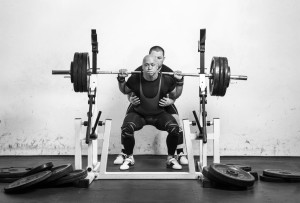 Most people who lift weights crave the idea of rapid strength gains. Rapid gains are possible for people who have the type of physiology that is highly responsive to weight training when they employ a very aggressive style of high intensity training. There are lifters who have made enormous gains in a short amount of time, but what I want to emphasize is that the type of training that is best for producing rapid gains is not always the best type of training for producing consistent gains over a long period of time. Just as runners understand that that sprinting and long distance races must be run in a very different manner, lifters need to understand that going for quick gains versus long term gains will require different types of training.
Most people who lift weights crave the idea of rapid strength gains. Rapid gains are possible for people who have the type of physiology that is highly responsive to weight training when they employ a very aggressive style of high intensity training. There are lifters who have made enormous gains in a short amount of time, but what I want to emphasize is that the type of training that is best for producing rapid gains is not always the best type of training for producing consistent gains over a long period of time. Just as runners understand that that sprinting and long distance races must be run in a very different manner, lifters need to understand that going for quick gains versus long term gains will require different types of training.
Very Aggressive Training
One of the most popular methods for making rapid gains is the 5 by 5 workout consisting of 5 sets of 5 reps on basic exercises. It can be done in a very aggressive manner in order to make quick gains, or it can be done in a more systematic manner with a more conservative intensity in order to make consistent gains over a longer period of time. If you are in the beginning stages of training, and your body is highly responsive to weight training, you can engage in aggressive five by five training. You simply choose a few basic exercises such as bench presses, squat, and bent over rows, and do them for 5 sets of 5 reps. If your body is highly responsive to weight training, you may be able to add five to ten pounds each workout; it is a simple matter of adding weight to the bar each workout and pushing yourself hard enough to do 5 sets of 5 reps with the added weight. Not everyone can gain this quickly, but a small percentage of people can.
There are other forms of training that may produce rapid strength gains. Max Aita is an outstanding lifter who had the privilege of training with the Bulargarian lifters while being coached by the Bulgarian coaches; including the world renowned Ivan Abadjev. Abadjev developed a high frequency training method in which lifters would work up to a heavy single rep max lift for a given exercise in every workout. This would often be done three times per day and the same exercises were repeated every day, and sometimes in more than one workout per day.
When using this type of extremely aggressive training, Max tells about the rapid progress he was able to make. I am listing the rate at which Max gained strength for the front squat, which will be followed by videos where he discusses these gains.
Max’s front squat went from 363 pounds to 477 pounds in six weeks.
He trained another eight months to improve from 477 pounds to 506 pounds.
He then trained nine or more months to improve from 506 pounds to 528 pounds.
Max Aita
Max also talks about a period of time where a sore elbow kept him from doing any cleans, snatches, or front squats; all he could do was back squats. Because of this, he was instructed to stop doing the exercises that hurt his elbow and do heavy back squats up to eight times per day. When he did this, his strength went up by 30 kilos (about 65 pounds) in less than a week! How’s that for rapid gains! Even though Max used Bulgarian high frequency maximum effort training with a great deal of success, I don’t recommend it unless you are supervised by a very knowledgeable coach as it can lead to severe fatigue and injuries.
Part 1
part 2
Aggressive Training and Plateaus
I bring up this story about Max Aita because in spite of the fact that he made some spectacular gains in a very short amount of time, he also recognized that the same aggressive style of training that led to super-fast strength gains also led to a sticking point that was holding him back from making consistent long term gains. He eventually changed his training style and started to gain again, but he had to be more systematic and patient.
It is important to understand that training programs that produce rapid gains often look like the best programs. Lifters often cling to a program that once brought super-fast gains because it appears to be highly effective. However, the same training program often stops working and becomes the culprit for an eventual training plateau. Another form of training is necessary that may not produce rapid gains, but it works on consistent basis over time. One lifter who was able to make long term gains that were consistently repeated year after year was Ed Coan. In the next article, I will share some of Ed Coan’s wisdom in regard to how he kept gaining strength year after year. Best of training to you.
The Value of An Even Rep Pace
If you have done any reading about precision point training, you will probably notice that I often mention the importance of maintaining a steady even rep pace. Why is this important? Because as long as you can maintain a steady even rep pace, the creatine phosphate system within your muscles is acting as the dominant energy fuel provider for muscle contractions. This is desirable because the creatine phosphate system is the most powerful energy system for enabling powerful muscle contraction.
In contrast, when you can no longer maintain a steady even rep pace due to fatigue, the lactate system is taking over as the dominant fuel provider for muscle contractions. The lactate system is inferior to the creatine phosphate system in terms of providing quality fuel for powerful muscle contractions. If your goal is to gain strength, you should focus on creating conditions that cause the creatine phosphate system to increase its capacity, not the lactate system. This is done by repeating reps only as long as you can maintain a steady even rep pace.
The Problem With a Steady Rep Pace
The only problem with using a steady even rep pace as a gauge for when to stop a set is that some lifters make no effort to maintain a steady even rep pace when they lift. Lifters who do this have no bases for determining their capacity for repeating reps while in the creatine phosphate system. This means that one of the prerequisites to being able to use precision point training in an effective manner is to learn to use a steady even rep pace for as long as possible when performing a set.
If you watch the following video, you will see two lifters. The first is performing floor presses using a steady even rep pace. He stops when he reaches his limit of being able to repeat reps at a steady rep pace. The rep pace of the second lifter is a little less consistent. This will make it more difficult for him to determine when he has reached the capacity of his creatine phosphate energy system.
There are many bodybuilders and powerlifters who use an even lifting rhythm as long as possible when performing a set, however, I need to make a clarification; maintaining a steady even rep pace does not mean that a lifter is not allowed to pause at the top or bottom of a rep. You may see lifters who always pause at the top or bottom of a rep, but they always pause the same amount of time and use the same rep speed and lifting rhythm for each rep. In this case, they are repeating reps at the same pace. Some lifters also tend to prefer slower reps while others prefer fast reps, but if they are using a steady even rep pace, they will do each rep the same way within a set. This is true of both Dorian Yates and Arnold Schwarzenegger as you can see if you watch the next two videos. Dorian Yates prefers slower reps with a pause in the contracted position, and Arnold Schwarzenegger does his reps a little faster without pausing at the top or bottom, but both are consistent in terms of the speed and manner in which they repeat their reps.
Dorian Yates: Former Mr. Olympia
Arnold Schwarzenegger: Perhaps The Most Famous Bodybuilder Ever
When a lifter pushes to failure but they do so by maintaining a steady even rep pace as long as possible, it is easy to identify the point in the set where rep speed starts to slow down. In the following video, Arnold maintains a steady even rep pace for nine reps when doing the bench press. He then slows down on his last three reps. Obviously, Arnold thrived on high intensity training and pushing to failure, however, if you do not respond as well as Arnold did to pushing sets to failure, you would want to stop when your rep pace starts to slow down.
Arnold: 9 Even Paced Reps followed by 3 Slower Reps
By this point in the article, hopefully you will conclude that it helps to be aware of whether or not you are using a steady even rep pace as long as possible when you perform a set. If you find that you are not using a steady lifting rhythm, it would be beneficial to start doing so because it will help you to identify your capacity to repeat reps while in the creatine phosphate system. This will help you to train more effectively. Best of training to you!
Precision Point Training
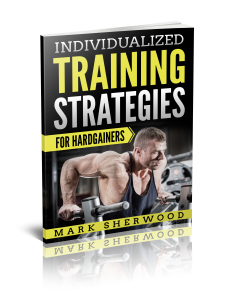 There are three basic keys to strength training success. The three keys consist of:
There are three basic keys to strength training success. The three keys consist of:
- Learning to do exercises with excellent form.
- Training at an optimal intensity that is hard enough but not too hard.
- Adding weight at the right rate.
If you add weight faster than you should, you will throw yourself off from using the right level of intensity. Once your intensity is too high and too much weight is used, lifting form tends to deteriorate and all three keys to weight training success will be out of wack. Likewise, if you start out using a level of intensity that is too high, it makes it hard to add weight on a consistent basis and it also makes it very difficult to use excellent exercise technique. In other words, all three keys to weight training success tend to affect one another and if one of them gets off course, the others tend to suffer as well.
Precision Point Training
The focus of precision point training is to use precision points in order to determine an optimum level of training intensity. It also requires that you add weight at a rate that allows you to stay within the boundaries of each precision point in order to give you the ability to keep adding weight over the course of long term training. What if you attempt to speed up progress by exceeding the boundaries of precision points, will it speed up progress? Perhaps you will gain quicker, but you will also hit a plateau quicker. In the end, you won’t gain as much.
If staying within the boundaries of precision points plays such an important role for achieving consistent gains, what are the precision points that should be utilized in training? In this article, I will discuss the first precision point which deals with training intensity in terms of how hard to push a set.
The First Precision Point
The first precision point lies between the limit rep and the marker rep as these reps give you a specific stopping point that is designed to allow you to make consistent progress over time. Do not assume as I once did that pushing for max reps to failure is necessary to stimulate muscle growth and strength. Instead, learn how to monitor each set in terms of how long you can maintain a steady even rep pace as this will help you determine an effective stopping point for terminating your set. You can stop a set when you reach the first rep that starts to slow down; this is called the marker rep as it marks the point in the set where you rep speed and/or rep pace begin to decelerate. You can also stop on the rep immediately before the marker rep, which is called the limit rep. The limit rep is the limit of reps that you can perform using a steady even rep pace. When you stop at your limit rep, every rep looks the same; you never reach the point where you can see that your reps are starting to slow down. The following video is a perfect example off this.
Having explained all of this, I understand that precision point training will never work for some people because of their training style. There are ways that people execute their reps that undermine precision point training. This isn’t necessarily bad when using other forms of training, but when using precision point training, certain styles of rep performance become a problem that negates the ability to determine when the limit rep and marker rep occur. In the next article, I will discuss these problems and how to correct them if precision point training is being used. Best of Training to you!
High Frequency, High Density, Heavy Lifting
 Some of my favorite lifters are: Richard Hawthorne, Charles Staley, Eric Spoto, and Andrey Malanichev. As much as I admire them, I don’t train like them because they all tend to prefer low frequency training, and I have never responded well to low frequency training. In fact, I much prefer high frequency training simply because it tends to work better for me when the right training conditions are applied. What are the right conditions?
Some of my favorite lifters are: Richard Hawthorne, Charles Staley, Eric Spoto, and Andrey Malanichev. As much as I admire them, I don’t train like them because they all tend to prefer low frequency training, and I have never responded well to low frequency training. In fact, I much prefer high frequency training simply because it tends to work better for me when the right training conditions are applied. What are the right conditions?
- Low to medium training volume per workout
- A medium amount of training intensity
- Small but consistent progression
- Work up to fairly heavy weights if you are between the ages of eighteen to thirty-five. (Older lifters may not do as well when going heavy on a regular basis)
The conditions that I just listed for high frequency training are the conditions that I am going to apply to a workout that I am going to discuss in this article. It is also a high density workout, which means to use a quick workout pace in order to work up to a heavy lift in a short amount of time. In fact, the workout consists of 27 sets and is designed to be completed in 27 minutes. The workout should be done at least four times per week. It is not a hard workout, but you don’t have to kill yourself when you do high frequency workouts. The volume and intensity do not have to be high, they only need to be “enough” because the frequency is high, and the frequency is the he primary stressor.
The 27 set 27 Minute Workout is listed below
Choose three basic exercises consisting of
- A pressing exercise
- A squat, or a deadlift, or leg press (just choose 1)
- A pulling exercise such as bent over rows, pulley rows, or lat pulldowns (just choose 1)
Each exercise is to be done for nine sets as follows:
Set 1: 5 reps using 50% of your Single Rep Max (abbreviated: SRMax)
Set 2: 5 reps using 55% SRMax
Set 3: 5 reps using 60% SRMax
Set 4: 3 reps using 65% SRMax
Set 5: 3 reps using 70% SRMax
Set 6: 3 reps using 75% SRMax
Set 7: 1 rep using 80% SRMax
Set 8: 1 rep using 82% SRMax
Set 9: 1 rep using 85% SRMax
A Quick Workout Pace
When doing this workout, move from set to set quickly by striving to keep the rest periods between sets no longer than 45 seconds. It is a high frequency, high density, heavy workout which means your goal is to get a lot of work done in a short amount of time as you work up to a heavy lift for each exercise. Ideally, you should get nine sets finished in eight minutes. Once you have completed one exercise, start on the next exercise within two minutes. The workout is designed to take 27 minutes. Remember, it’s not a super hard workout but when you do it on a high frequency basis, you will get better at it and be able to add on a little at a time. Ideally, the workout will never become super hard, even though you will be incrementally adding to it on a regular basis, which leads me to the next point.
Progress With Microloading
I am a great believer in microloading because it is the easiest way for your body to adapt to gradual increases in weight. You can make it a goal to add a pound per week to every set without feeling as though the added weight is becoming more and more difficult to lift over time. Make sure to add a pound to all nine sets, not just the last set. Adding a pound per week would add up to a strength gain of 52 pounds by the end of a year.
Add Weight at The Right Rate
Adding a pound per week is not a requirement. Beginners and intermediates may be able to add a pound every workout or every other workout. If you do four workouts per week, the added pound per workout will add up to over 200 pounds of added weight within a year. Others who have been lifting for many years generally do not gain as quickly and may only be able to add a pound every other week which would be a 25 pounds strength gain within a year. The bottom line is to add weight at a rate that works for you and adjust by adding more often or less often according to the difficulty of the workouts. If you notice the workouts become significantly harder and you start to struggle with the added weight, cut back and add less frequently. If it feels like the workouts are getting easier and easier even though you are adding a pound once per week, then try adding a pound twice or three times per week until your level of effort stabilized from week to week.
If you like simple workouts that can be done quickly, you can try the 27 set, 27 minute workout for a period of time. If it works, keep doing it. If it doesn’t work, or it stops working at some point, make adjustments or try something else until you find something that does work. While there a weight training principles that I tend to favor, the number one principle that I favor is to let results be the final word on how you should train. Best of training to you.
Russian Lifters: What We Can Learn From Their Workouts
The Russian lifters are among the strongest in the world. Why is this? Is it just because they are Russians and Russians have good genetics for getting strong? I doubt that this is the only reason because there are people of Russian descent all over the world. They have Russian genetics, but they are not as strong as the Russians from Russia. What about steroids? Once again, people from all over the world take steroids, but they aren’t necessarily as strong as the Russians.
I believe the Russian lifters have good coaching and they know how to work out. A lot of their success comes from good programming and periodization, but in this article I want to focus on their mental approach, and even more on their technique and approach to each set, each rep, and each lift.
Perfect Form, Perfect Pace, Perfect Feel
One thing I notice is that Russian liters are fairly calm when they train. For the most part, they don’t psych themselves up, they don’t yell, they don’t scream, they just lift. They seem to believe that an effective training process is what produces progress, not psych, strain, and struggle. Instead of using their minds to psych themselves up, they use it to focus on perfect form, perfect pace, and perfect feel. They want each rep to feel good, not hard. Yes, training heavy is hard, but the focus is not on hard, it’s on lifting a heavy weight with the best form possible, which will make it as easy as possible to lift a heavy weight.
Every rep is the same; no pauses, jerking, shaking, or grinding within a lifting motion, just smooth lifting perfection. Form and rep speed are never compromised by fatigue because they don’t push to the point where fatigue hinders form and rep speed. When fatigue produces bad form and slower rep speed, it teaches the nervous system sub-optimal nerve firing patterns, so it is not done when training for strength, although it may be done when occasionally testing for strength.
Practice Until It Gets Easier
Many of the Russians are known for using a lot of training volume and a moderately high frequency. They don’t kill themselves with intensity, but they use plenty of training volume and frequency to practice with perfection over and over again until they get better at it. When they get better, the weights become easier to lift. Any time weights become easier to lift, you can add more. This is far different than the common mindset of trying to make training as hard as possible and then trying to add to it whenever you can. Common sense tells you that when lifting becomes easier you can easily add to it, but when you always push to make your training harder, it is very hard to add to it.
Practice, Don’t Perform: Train, Don’t Test
One of the dangers of watching youtube videos of lifters is that they are often performing for the camera and are going for a record single or a record in terms of max reps. Practice and performance are not the same. Practice is done as perfectly as possible in regard to form, consistent rep speed, and a fluid lifting motion. In contrast, performing is done by lifting as much weight as possible or doing as many reps as possible, even if it causes a compromise in form, force, consistent rep speed, or a fluid lifting motion. The goal is to consistently practice and train for strength, instead of constantly performing and testing for strength.
Watch the Russians train in the video at the end of this article, but make sure you watch for the right things. Don’t just look at how big they are because you can’t imitate that, besides, the lifters are all different sizes, but they are all strong. Don’t look at how much weight they are lifting because you won’t be able to imitate that either unless your strength level corresponds to theirs. The one thing you can imitate is their focus on form and a fluid lifting motion on every rep of every set. It’s better to train for maximum perfection before you try for maximum performance. Best of Training to you!
What The Right Amount of Effort Looks Like
Some lifters work out by doing a warm up and then use the same weight and same number of reps for all of their work sets. This method is often used when doing three sets of eight, five sets of five, or eight sets of eight reps. Other lifters like to increase the weight each set until they reach a top weight for their last set. Both methods are effective, but in my opinion, the key factor that makes either method work is to find the sweet spot in terms of using the right amount of effort.
Ambition and Training Too Hard
I know that there is a large percentage of people who have lifted weights who have never put forth the necessary effort on a consistent basis in order to make significant progress. Lack of effort will always be one of the primary reasons for lack of achievement. However, among highly ambitious and enthusiastic lifters, the problem is often that they push too hard and their form breaks down, or they end up doing a lot of grinder reps on their last couple of sets. Poor form and doing too many grinder reps is one of the biggest causes of a training plateau. Of course if someone is making a lot of progress by doing a lot of grinder reps and pushing super hard on every set, then I would not advise them to change. However, if they have hit a plateau, I would definitely suggest the following guidelines regardless of whether they like to repeat sets with the same weight and reps from set to set, or they prefer to add weight to each set as they proceed from set to set.
Guidelines For Training With the Right Amount of Effort
- Each rep of a set should look the same in terms of rep pace, rep speed, and using good form. If your rep speed slows down at the end of the set, you are using too much weight.
- When using the same weight and reps for each set, each set should look the same in terms of rep speed, the time it takes to complete the set, and using good form.
- When increasing the weight from set to set, do not use so much weight that you start grinding as the weight becomes heavier. Always maintain the ability to utilize a steady even rep pace with perfect form on all of your sets; including your heaviest set.
The Right Amount of Effort: What it Looks Like
The following videos provide excellent examples of lifters who have found the sweet spot in terms of using the right amount of effort for the amount of sets, reps, and weight they are using. Their lifting fits into the suggested guidelines because most of the reps look the same, and most of the sets look the same from start to finish. The lifter in the first video uses the same weight and reps for each set, while the lifter in the second video increases weight on each set. Since he is a bodybuilder, he is using fairly slow reps. I would suggest lifting with more force for those who are more focused on pure strength training. However, both videos provide a demonstration of how to train hard enough to stimulate strength without pushing so hard that it becomes counterproductive.
5 x 8 with the same weight on each set
5 x 5 Increasing Weight Each Set
You may feel as though you are sacrificing the amount of weight that you use when following these guidelines and assume that this will cause you to lose strength. This is possible, but as you continue to repeat workouts, you will find that your strength will come back, and the most important thing is that you will be able to make consistent progress again.
When you follow the suggested guidelines, add weight only when you are truly ready. People think you can’t get stronger by repeating the same workouts with the same weights. In other words, they think you can’t get stronger until you have added weight first, but the opposite is true. If you work out with the right amount of effort, you will start to gain strength and the same weight will become easier to lift. Once the weight becomes easier to lift, you will be able to add weight without compromising on using good form, maintaining a steady even rep pace, and only repeating sets for a muscle group as long as it is at full strength. This often works much better than trying to will yourself and push yourself to keep improving. Try these suggestions any time you are stuck and need to make start making progress again. Best of training to you.
High Frequency Undulating Training
 One of the reasons that I prefer high frequency training is that it opens the door to a vast amount of training options. One of those options is to undulate back and forth between higher volume and lower volume training. I will give an example of this type of training in this article.
One of the reasons that I prefer high frequency training is that it opens the door to a vast amount of training options. One of those options is to undulate back and forth between higher volume and lower volume training. I will give an example of this type of training in this article.
When the idea of undulating training is discussed, it often refers to undulating back and forth between various weights and rep ranges from workout to workout. Workouts with the same weight and repetitions are not repeated in two consecutive workouts, but I am going to break that rule when the undulation is done in the context of high frequency training.
The type of high frequency training that I will be discussing consists of hitting the same muscle group (or muscle groups) each day, six days per week. Each week is divided into two sections. The first section consists of the first three days of the week in which lighter weights and more volume are used. The second section consists of the next three days and consists of heavier weight and less volume. Let’s imagine that you will be doing squats six days per week while undulating back and forth between high volume and lower volume training every three days. The weekly schedule for your squat workouts is listed below:
Note: Percentages listed are based on your single rep max which is abbreviated as 1RMX
Days 1 – 3 Do all 9 sets listed for each workout:
Sets 1-3: Do 3 sets of 12 reps with 40% of 1RMX (add 5 pounds after week 1)
Sets 4-6: Do 3 sets of 10 reps with 50% of 1 RMX (add 5 pounds after week 2)
Sets 7-9: Do 3 sets of 8 reps with 60% of 1RMX (add 5 pounds after week 3)
Days 4 – 6 Do all 7 sets listed each workout
Sets 1-3: Do 3 sets of 5 reps with 60% of 1RMX (add 5 pounds after week 4)
Sets 4-5: Do 2 sets of 5 reps with 70% of 1RMX (add 5 pounds after week 5)
Sets 6-7: Do 2 sets of 5 reps 75% to 80% of 1 RMX (add 5 ponds after week 6)
Why Undulation?
The idea behind undulating between higher volume and lower volume training is that the higher volume training will condition your muscles to be able to handle a substantial total workload. When you switch to using heavier weight with lower overall volume during days 4 – 6, your body will be able to handle the added weight easier because there will be concurrent reduction in sets, reps, and overall volume.
Use The Right Amount of Effort
The workouts outlined are not killer workouts because the idea is not to kill your muscles, but to set them up so that you can keep adding weight on a consistent basis from week to week, month to month, and even year to year. If you train with the right amount of effort on a high frequency basis, your body will gain strength to keep increases of weight from feeling as though they are becoming more difficult to lift. If you are performing these workouts with the right amount of effort and add weight at the right rate, you should be able to perform the last rep of your last set without grinding or struggling to lift the weight, and you should be able to maintain a smooth nonstop lifting motion on all of your reps throughout each workout.
One of the keys to this type of training is to give your body a regular dose of training that is very manageable for your body. The common mindset with most training methods is to put a lot of stress on your muscles and never let them get comfortable with the workouts. I have found that the rules change with high frequency training; you don’t have to make your body highly uncomfortable in order to keep gaining, rather you want your body to grow comfortable with the training so that you can eventually add more weight. Once your body becomes comfortable with the added weight, you can add more weight again. Frequency and consistency is what allows your body to become comfortable with the weights you are using. Any time your body becomes more comfortable with the weight you are using, you will be able to keep adding more weight without hitting a plateau.
I’m guessing that this will all seem extremely ridiculous to intensity minded people. At one time, I was one of those people. I thought high intensity was the only thing that mattered when it came to producing results. I believed that anything less than 100% intensity was stupid, counterproductive, and a complete waste of time. However, I reached a point where I was willing to experiment with less intensity and more consistency and frequency, and it worked because I gave it time to work. Many people who gain quickly as a beginner expect to always gain quickly any time they try a new form of training. The training outlined in this article may not produce super quick strength gains, but it will set your body up to keep on gaining if you know how to add weight in a sensible manner.
Progression
When it comes to adding weight, you can add five pounds every week to one of the percentages of weight that is used in the training program that is outlined. For example, after week one, you will add five pounds to your sets that are done with 40% of your single rep max. After week two, you will add five pounds to the sets that are done with 50% of your single rep max. Every week, add five pounds to the next percentage listed. By the end of week six, you will have added five pounds to each percentage listed and will be using an additional five pounds for all of your sets in each workout. If you repeat this every six weeks, it will add up to a 40 pound increase in weight within a year. Keep it up for 3 years and will be 120 pounds stronger in all your lifts. If gaining 40 pounds of strength over the course of year is not enough, you can try adding seven pounds, or ten pounds instead of five pounds. However, if you add weight at a faster rate than your body gains strength, you will start straining, struggling, and grinding, and it won’t be long before you burn out on high frequency training.
For those who need a change and have the time and enthusiasm to engage in high frequency training, high frequency undulating training is a viable solution. When properly applied, many of you will find it to be an effective from of training. Best of training to you.
EDT and Precision Point Training
 One of my favorite lifters, coaches, and thinkers within the arena of weight training is Charles Staley. I like Charles because we share at least three common traits; First we are both well into our fifties, but we don’t think it should be a liability to our performance. Second, we both like to think outside of the norm; not just to be different, but to search for more effective training methods. Third, Charles would say that he does not possess a large amount of physical talent, and I would definitely say the same thing about myself. The only way to compensate for this problem is to keep seeking better ways to train.
One of my favorite lifters, coaches, and thinkers within the arena of weight training is Charles Staley. I like Charles because we share at least three common traits; First we are both well into our fifties, but we don’t think it should be a liability to our performance. Second, we both like to think outside of the norm; not just to be different, but to search for more effective training methods. Third, Charles would say that he does not possess a large amount of physical talent, and I would definitely say the same thing about myself. The only way to compensate for this problem is to keep seeking better ways to train.
Do As Many Total Reps as Possible in 15 Minutes
One method that Charles has come up with for improving muscle mass and overall conditioning is called EDT, which stands for Escalating Training Density. Training density refers to doing as many total reps as possible within a given time period. In the case of EDT workouts, the traditional time period consists of about 15 minutes. Normally, two exercises are performed during the 15 minute time period and you would alternate back and forth between the two exercises from set to set. The two exercises are usually for opposing muscle groups, such as back and chest, biceps and triceps, or quads and hamstrings. An example would be to alternate back and forth between bench press and seated pulley rows with the goal of doing as many total reps for each exercise as possible in fifteen minutes.
Pace Yourself In Order To Do More
One of the aspects of EST workouts is that there is no rule in regard to how many reps must be done for each set. One of the primary ideas is to pace yourself in order delay and reduce fatigue as much as possible over the course of the workout. This is necessary in order to do as many reps as possible.
Pushing to failure on your first set will quickly produce a lot of fatigue and hinder you from doing as much work as possible later on in the 15 minute period. It is better to start out by only doing half as many reps as you would normally do if you were pushing close to failure. In other words, if you can do 10 reps for the bench press, just do 5 reps and move quickly to another exercise such as seated pulley rows for 5 reps. You would keep switching back and forth between bench press and seated pulley rows for 5 reps until it becomes difficult to keep doing 5 reps per set. At that point, you could reduce to just 3 reps per set in order to keep moving fairly quick from set to set. You may even be down to 2 reps per set by the end of the 15 minute period.
Goal: Do More Total Reps in 15 Minutes
The important thing is to keep track of the total amount of reps that you do for each exercises in 15 minutes over the course of each workout. As you continue to do workouts, your goal is to improve by doing more and more total reps in 15 minutes. There are two basic methods for accomplishing this
The first is to do more reps per set for some (or all) of the sets within the same time period.
The second is to reduce the amount of rest between sets in order to do more sets within the same time period.
If you succeed at doing more work in the same amount of time, chances are good that your strength has improved, and you will be able to start the process over with more weight.
EDT and Precision Point Training
I think that EDT is an excellent way to make progress if you are tired of just trying to add more weight as the only means of progression. When I use this form of training, I tweak it to fit within precision point training concepts. This means that I will only alternate back and forth between two exercises until I sense that my strength starts to drop, then I stop and rest for at least three minutes. For me this will work out to be three or four sets of 5 reps for each exercise when using a weight that I can normally do for 10 strong reps. After three or four sets of 5 reps, I rest 3 minutes and do another three to four sets of 4 to 5 reps over the course of 5 minutes. I would never push to the point where my rep speed starts to slow down from one rep to the next, or from one set to the next; I want my last set to look a lot like my first set in terms of form and rep pace, and I want to finish strong.
If I can add just one rep to one of my sets over the course of each five minute exercise period, I know I have made progress. I may also reduce the rest time between sets a little to see if I can do more sets within the 5 minute exercise period. My goal is to eventually increase from 15 or 20 reps in each 5 minute period to 25 reps in each five minute period. If I succeed, I increase the weight and start the process again.
If you experiment, you may find your own version of EDT that works for you. The key is to find the right number of minutes to do an exercise, as well as to find an intensity level that works, and a frequency that works. If you do, EDT is going to work for you. Best of training to you.
If you want to hear a little about EDT from Charles Staley who is the originator of EDT, and see his training method in action, refer to the following videos:
Short Term vs. Long Term Training Strategies
 If you happen to find a weight training system that brings quick results, you are fortunate. At the same time, you are at risk for buying into using that same system for a life time because the initial results were so promising. This can be a problem for a long term lifter because lifting that brings quick results can just as quickly lead to a training plateau. There may be other approaches that don’t cause gains to come as fast, but they work better in terms of long term consistent results that don’t lead to a plateau.
If you happen to find a weight training system that brings quick results, you are fortunate. At the same time, you are at risk for buying into using that same system for a life time because the initial results were so promising. This can be a problem for a long term lifter because lifting that brings quick results can just as quickly lead to a training plateau. There may be other approaches that don’t cause gains to come as fast, but they work better in terms of long term consistent results that don’t lead to a plateau.
After years of training, I have come to the point where I believe that weight training progress works a lot like different types of races. You can sprint, you can run middle distance, or you can run a long distance race. Your strategy for each type of race will be different. If you try to sprint when doing a long distance race, it will actually slow you down in the end. You may be way ahead of everyone else at the start of the race, but you will quickly run out of gas and get passed up. In contrast, if you use a long distance pace for a 40 yard dash, you will get beat and look pathetically slow.
Within the realm of weight training, there are training methods that are the equivalent of sprinting because they produce quick results for a short amount of time. In contrast, you can use training methods that produce slower results, but they eventually result in more progress over a longer period of time. Having said that, I will give you my perspective on training methods that produce short term gains, medium term gains, and long term gains.
High Intensity: A Short Term Perspective
I made my best gains and my fastest gains with high intensity training. I didn’t go high intensity on every set, but I worked up to high intensity in the vast majority of workouts. In the process, my bench press improved by about 60 pounds, and my squat and deadlift improved by close to 100 pounds in three months. I thought this was such good progress that I was sold on high intensity training for years. The problem was that it didn’t work for years, it only worked for three months and then it quit working. Would I ever tell someone not to use high intensity training? No, I would tell them to use it as long as it is working, but if it quits working, quit doing it.
Training Thresholds with Heavy weights: A Medium Length Perspective
My experience with high intensity training is that it doesn’t work forever, although if someone experiences long term ongoing gains from high intensity training, they should keep doing it. Since it doesn’t work for me in the context of long term progress, I experimented until I found something that did work. What worked was training thresholds which I also refer to as precision points. Precision points are based on strong training which means to only repeat sets for a muscle group as long as it is at full strength, and only repeat reps of a set as long as a steady even rep pace can be maintained. This is all that is necessary to stimulate strength and your body can handle this type of training over and over again on a fairly frequent basis without burning out or stalling out.
Light Weights: A Long Term Perspective
At the time of this writing, I am about one week shy of reaching my 55th birthday. By necessity over the last few years, I have had to often resort to the use of light weight to keep from agitating or reigniting old injuries. Anytime I switch to light weights, I admit that I start to lose strength. However, what I have found out about light weights is that you can keep adding little by little over time and the weights keep feeling light, even though the weight is increasing and getting heavier. The result is that my strength eventually comes back to its previously level, but it takes the better part of a year before my strength is regained. This makes it seem like progressing with light weights is a long slow tedious process that doesn’t work very well. However, the gains keep coming a lot longer before encountering a plateau. This is not evident unless you are forced to stick with light weights for a long time, which most people never do. The bottom line is that if you know how to use light weights properly, they can prove to be beneficial in the context of long term training and lifetime lifters.
Light Weights Must Be Used Correctly to Be Effective
Having said that light weights are effective when used as a long term strategy, I need to clarify that I have found plenty of ways to make no progress at all with light weights. The worst way to make progress with light weights is to think that you can do three sets of eight reps once or twice per week and make progress like you would with heavy weights. Wrong. More volume and frequency is needed when using light weights. The second big mistake is to assume that you must train to failure in order to get anything out of your workouts with light weights. Wrong again. Training to failure with light weights allows you to do way too many reps beyond the proper stopping of a set.
With heavier weights, I advise stopping a set at the point where a steady even rep pace can no longer be maintained. When using a lighter weights that are 50% or less than your single rep max, I advise you to stay relaxed as long as possible and to stop a set when you feel your body suddenly start to tighten up. It is also very important to repeat sets only as long as the muscle group being trained is at full strength. If you adhere to these boundaries, you can and should train each muscle group three to six times per week. A final important factor is to add weight to your lifts little by little by micro-loading a half pound to a pound per week, and you will be able to keep on adding weight for a long, long time which is the goal of a long term weight training plan. Eventually those light weights are going to get heavier, but they will still feel light because you will be getting stronger.
I realize that the perspectives that I just shared in regard to training with light weights does not fit into the traditional view point on how to build strength, but I have found it to be true almost by accident in order to avoid injuries. What I want to emphasize is that training methods that work quick and fast should be used if your goal is to obtain results as quick and fast as possible, but if your goal is long term progress, there are training methods that may seem inferior because they work slower, but they work more consistently over a long period of time. Best of training to you.
Need evidence that training with light weights can be an effective long term training strategy? Take a look at Serge Nubret at age 54. Serge rarely used more than 50% of his single rep max, but relied on plenty of training volume with light weights to develop his size and strength. Even though Serge was a bodybuilder, not a weight lifter, he could bench 500 pounds raw at a bodyweight of just over 200 pounds.
How To Get Stronger By Adding Reps and Sets
 If you want to get stronger, then adding weight to your lifts is probably the most common method for achieving your goal. Another way to grow progressively stronger is to add reps to the same amount of weight. In my opinion, adding weight is better than adding reps when training with 70% or more of your single rep max. However, when using lighter weights, adding reps can also be an effective method for stimulating strength gains.
If you want to get stronger, then adding weight to your lifts is probably the most common method for achieving your goal. Another way to grow progressively stronger is to add reps to the same amount of weight. In my opinion, adding weight is better than adding reps when training with 70% or more of your single rep max. However, when using lighter weights, adding reps can also be an effective method for stimulating strength gains.
In this article, I am going to give you a simple progression that is based on adding sets and reps to the same amount of weight in systematic manner. Since the progression is based on adding sets and reps, the weights will not be excessively heavy, but will probably be about 55 to 60% of your single rep max.
The progression system is based on using a weight that allows you to do 6 sets of 6 reps for each exercise. This is to be done Vince Gironda style, which means short rests of about 20 seconds between each set. The final goal is to progressively increase the amount of sets and reps until you have progressed from 6 sets of 6 reps to 8 sets of 8 reps with the same amount of weight. The increase from 6 sets of 6 reps to 8 sets of 8 reps will cause a substantial increase in total workload and will produce a significant increase in strength.
Important: Start With the Right Amount of Weight and Effort
Any time the goal is long term progression, it is crucial that you start with the right amount of weight and the right amount of effort to insure success. If you are in a hurry and start out too heavy, you may progress faster, but you will also hit a plateau faster. If you start with the right amount of weight and effort, you will be able to progress indefinitely.
Don’t pick a weight with 6 sets of 6 reps that requires you to kill yourself with a heroic effort to squeeze out 6 sets of 6 reps. It’s far better to find a weight that will allow you to complete all 6 sets using a steady even rep pace for every rep of every set. In other words, you first and last set should look exactly the same in terms of rep speed and rep pace. You will probably be able to use 55 to 60% of your single rep max if you are only resting 20 seconds between sets. It is also important that you train each muscle group three times per week. Once you have chosen an ideal amount of weight and effort for 6 sets of 6 reps, you are ready to begin the progression, which is explained in the following steps:
Step 1
Do 6 sets of 6 reps for each exercise during week one.
It is imperative that you use a weight that allows you to maintain a steady even rep pace for all six reps on your last set. If the amount of effort is too hard when you start out, it will mess up the progression.
Step 2
Do 7 sets of 6 reps for each exercise
You may find that you cannot maintain a steady even rep pace for your last set of 6 reps. Keep repeating workouts with 7 sets of 6 reps until you can do all six reps of your last set using a steady even rep pace. Your first and last set should look the same in terms of rep speed and rep pace.
Step 3
Do 8 sets of 6 reps for each exercise
Keep repeating workouts with 8 sets of 6 reps until you can do all six reps of your last set using a steady even rep pace. Your first and last set should look the same in terms of rep speed and rep pace.
Step 4
Do 6 sets of 7 reps with 20 seconds rest between sets for one week.
Step 5
Do 7 sets of 7 reps.
Keep repeating workouts with 7 sets of 7 reps until you can do all seven reps of your last set using a steady even rep pace. Your first and last set should look the same in terms of rep speed and rep pace.
Step 6
Do 8 sets of 7 reps.
Keep repeating workouts with 8 sets of 7 reps until you can do all seven reps of your last set using a steady even rep pace. Your first and last set should look the same in terms of rep speed and rep pace.
Step 7
Do 6 sets of 8 reps with 20 seconds rest between sets for one week.
Step 8
Do 7 sets of 8 reps.
Keep repeating workouts with 7 sets of 8 reps until you can do all eight reps of your last set using a steady even rep pace. Your first and last set should look the same in terms of rep speed and rep pace.
Step 9
Do 8 sets of 8 reps.
Keep repeating workouts with 8 sets of 8 reps until you can do all eight reps of your last set using a steady even rep pace. Your first and last set should look the same in terms of rep speed and rep pace.
Step 10
At this point you have two options. The first is to keep adding sets and reps until you progress from 8 x 8 to 9 x 8; to 10 x 8; to 8 x 9; to 9 x 9; to 10 x 9; to 8 x 10; to 9 x 10; to 10 x 10.
Believe it or not, you may find that it is easier to make consistent progress by progressing from 8 x 8 to 10 x 10, than it is to progress from 6 x 6 to 8 x 8.
Your second option is to add weight and go back to 6 sets of 6 reps. You should add enough weight so that you can’t do any more than 6 sets of 6 reps using a steady even rep pace. Repeat steps 1 through 9 with the added weight.
Heavy Weights vs. Light Weights When Adding Reps
Remember that adding reps to your sets is much easier with light weights than heavy weights. Let me give you an illustration:
If I can lift 200 pounds for 5 reps, the total workload across all five reps combined is 1000 pounds. In order to add another rep and do 6 reps, it would increase my workload per set from 1,000 pounds to 1,200 pounds, which is an increase 200 pounds and about 20% per set. On the other hand, if I were using lighter weights and did 100 pounds for 20 reps, the total workload for 20 reps would be 2000 pounds. If I grew strong enough to add on one more rep, it would increase my total workload from 2,000 pounds to 2,100 pounds, which represents an increase of 100 pounds, or about 5% per set. To put it into perspective, I must increase my workload by 200 pounds and 20% per set when adding a rep to heavier weights, compared to 100 pounds and 5% per set when adding a rep to lighter weights. My own opinion is that you won’t get strong as fast when starting out with light weights, but you may find it easier to keep on making long term progress when you start out light and gradually add on. Best of training to you.
Pyramid Your Cluster Sets for Strength
 This is the third and final installment of a series of articles on cluster set training. Cluster set training simply refers to doing mini sets with very short rest periods of ten to twenty seconds between mini sets. For example, instead of doing ten consecutive reps, you would use the same weight that you would use for ten reps, but you would do four mini sets of three reps each with about fifteen seconds rest between each mini set. The advantage to this is that more reps would be done (twelve as opposed to ten) and the reps would tend to be more forceful. Cluster sets are most often done with heavy weights and mini sets consisting of three reps or less, but there is no reason why you can’t use cluster sets with lighter weights and higher reps for each mini set.
This is the third and final installment of a series of articles on cluster set training. Cluster set training simply refers to doing mini sets with very short rest periods of ten to twenty seconds between mini sets. For example, instead of doing ten consecutive reps, you would use the same weight that you would use for ten reps, but you would do four mini sets of three reps each with about fifteen seconds rest between each mini set. The advantage to this is that more reps would be done (twelve as opposed to ten) and the reps would tend to be more forceful. Cluster sets are most often done with heavy weights and mini sets consisting of three reps or less, but there is no reason why you can’t use cluster sets with lighter weights and higher reps for each mini set.
How to Pyramid Your Cluster Sets
In this article, I will be discussing a cluster training variation in which you pyramid your reps and weight. Nick Nilsson has an excellent variation of this with heavy weights. When using his method, you can cram more quality reps with heavy weights into a short amount of time. Nick calls his version, “Wave Loading Cluster Training.” You do it by starting with a moderately heavy weight that is used for three mini sets consisting of 3 reps, then 2 reps, then 1 rep. This would form a single cluster of 3-2-1 reps. Three total clusters of 3-2-1 reps should be done, and the weight should be increased from one cluster to the next. Of course it is super important to rest only ten seconds between each mini set of 3-2-1. Once a cluster of 3-2-1 has been completed, Nick recommends resting 2 minutes before doing another cluster of 3-2-1. You can see Nick’s version of cluster set training in his video:
This same principle of increasing the weight from one cluster to the next can be used with lighter weights. For example, you can use about 55% of your single rep max and do a cluster of 10 reps, 8 reps, and 6 reps with 15 seconds rest between each set within the cluster. Follow this with a three minute rest and use 60% of your single rep max to do a second cluster consisting of 8 reps, 6 reps, and 4 reps. Rest another three minutes and see if you can get 6 reps, 4 reps and 2 reps with 65% to 70% of your single rep max for your final cluster.
Create Your Own Variation Within The Context of Sound Principles
Of course there are no rules to weight training and you may create your own variation of cluster training to fit your own goals, needs, and preferences. Even though there are no rules to weight training, I still believe in principles that promote effective training, and one of the principles that I firmly believe in is to work out within the boundaries of strong training. This means to use strong reps and strong sets. Strong reps are forceful reps that do not slowdown in comparison with previous reps in a set, and strong sets are sets that are done while a muscle group is at full strength. In other words, avoid fatigue to the point where your rep speed starts to slow down and your strength diminishes as your workout proceeds. Work to your capacity of strong reps on your last set of a cluster, and work to your capacity of doing as many clusters as you can without growing weaker. Follows these recommendations and you will find cluster set training to be an efficient way to gain strength by doing a substantial amount of training without the need for long, arduous workouts. Best of training to you.
Cluster Set Training 4 x 8 and 3 x 6
 In this series of articles on cluster set training, I started the series by discussing the most common way to perform cluster sets, which is to do three to five mini sets consisting of two to three reps each, with only ten to twenty seconds of rest between mini sets. This is usually done with fairly heavy weights that are between 70% to 80% of your single rep max. An example of cluster set training is shown in the following video.
In this series of articles on cluster set training, I started the series by discussing the most common way to perform cluster sets, which is to do three to five mini sets consisting of two to three reps each, with only ten to twenty seconds of rest between mini sets. This is usually done with fairly heavy weights that are between 70% to 80% of your single rep max. An example of cluster set training is shown in the following video.
The Benefit of Cluster Sets
The benefit of cluster sets is that the onset of fatigue is delayed because you are taking a short break every two to three reps. Of course this allows you to do more reps within a cluster of sets, rather than doing one nonstop set of reps. While cluster sets are traditionally done with heavy weights, there is no reason they can’t be done with lighter weights and more reps.
A Cluster of 8 Sets of 8 Reps
Vince Gironda was an enormously popular trainer in bodybuilding circles during the 1950’s through the 1990’s. Probably more than anyone else, Vince popularized 8 sets of 8 reps per exercise. There is a sense in which Vince’s version of 8 sets of 8 reps was one giant cluster set because Vince recommended resting as little as fifteen seconds between sets. The standard amount of time for the completion of 8 sets of 8 reps was three and a half to five minutes when the sets were performed according to Vince’s rapid paced method.
Two Clusters of 4 Sets of 8 Reps
In my later years of training, I have frequently done Vince’s 8 sets of 8 reps routine, but I have found that I can use more weight and get a better pump if I break 8 sets of 8 reps into two cluster sets. This is done by starting with a cluster of 4 sets of 8 reps with little rest between sets. A three to five minute rest is then taken and another cluster 4 sets of 8 reps is performed. It feels much better when I divide 8 sets of 8 reps into two clusters. I recommend using about 55% of your single rep max when doing two clusters of 4 sets of 8 reps.
Two to Three Clusters of 3 sets of 6 Reps
Vince is also famous for recommending 6 sets of 6 reps for a mass building routine. Just as the 8 sets of 8 reps routine can be divided into two clusters of 4 x 8, the 6 sets of 6 reps routine can be divided into two clusters of 3 x 6. Of course the rest between sets within a cluster should be brief, and the rest should be longer after completing a cluster before doing the next cluster. I also believe you can benefit from doing three clusters of 3 x 6, which would give you a total of 9 sets of 6 reps. I recommend using about 60% to 65% of your single rep max for clusters of 3 x 6.
Super Setting Clusters
Remember that a cluster of sets is done with little rest between sets until the cluster is completed, then you need to rest the muscle group you have been working for at least three to five minutes. However, you can just about cut your workout time in half by super setting clusters of two different exercises that work opposing muscle groups. For example, start with a cluster of sets for one muscle by doing bench press, then switch to a cluster of sets for seated pulley rows before returning to a cluster of sets for the bench press three to five minutes later. I have found this to be effective for upper body exercises, but if you switch back and forth between legs and upper body, the cluster of leg work might leave you out of breath to the point where it interferes with the quality of your workout.
Cluster set training is a great way to get in plenty of training volume with a reasonable amount of weight in a short amount of time. In the next article, I will discuss pyramid clusters. Best of training to you.
Cluster set Training
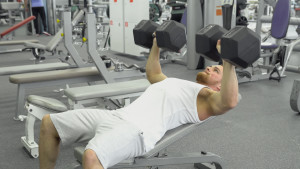 I have found cluster set training to be a highly effective method for building muscle size and strength in a minimum amount of time for each workout. An example of cluster set training would be to start by selecting a weight that you could do for eight reps if you pushed all the way to failure, however, you would only do three reps on your first set. After the first set, you would continue to repeat sets of three reps with only fifteen seconds of rest between sets for a total of approximately four sets. The four sets done in rapid succession would constitute a “cluster” of sets. It would be hard to do more than three reps by your fourth set if you were truly resting only fifteen seconds between sets. Once you finish the cluster of four sets, you would rest for at least four minutes and do another cluster of four sets of three reps with only fifteen seconds between sets. Most of what you hear and read about cluster training is based on using fairly heavy weights, but there is no reason why it can’t be done with lighter weights as well. You can refer to the following video for a variation on how to do cluster set training.
I have found cluster set training to be a highly effective method for building muscle size and strength in a minimum amount of time for each workout. An example of cluster set training would be to start by selecting a weight that you could do for eight reps if you pushed all the way to failure, however, you would only do three reps on your first set. After the first set, you would continue to repeat sets of three reps with only fifteen seconds of rest between sets for a total of approximately four sets. The four sets done in rapid succession would constitute a “cluster” of sets. It would be hard to do more than three reps by your fourth set if you were truly resting only fifteen seconds between sets. Once you finish the cluster of four sets, you would rest for at least four minutes and do another cluster of four sets of three reps with only fifteen seconds between sets. Most of what you hear and read about cluster training is based on using fairly heavy weights, but there is no reason why it can’t be done with lighter weights as well. You can refer to the following video for a variation on how to do cluster set training.
Cluster set training is a phenomenal way to increase your training volume and training density at the same time. Assuming you are pushing yourself, I would not advise doing more than two or three clusters per exercise. In the past, I have also referred to a cluster of sets as a series of mini sets. A series of four mini sets could be repeated two to three times for a total of eight to twelve mini sets consisting of three reps each. If you wanted to do an entire full body routine using cluster set training, the following workout could serve as an example that you could experiment with and adjust to suit your personal capacity, needs, and goals.
Full Body Cluster Set Routine
Do a few easy warm up sets with light weights before starting your cluster sets. Once you finish your warm up sets, I recommend increasing the weight to about 75 to 80% of your single rep max for your cluster sets.
The actual workout would be done using the following procedure with squats, and would then be repeated with bench press and seated pulley rows.
1st Cluster set
1st set: Do 3 reps
15 seconds rest
2nd set: Do 3 reps
15 seconds rest
3rd set: Do 3 reps
15 seconds rest
4th set: Do 3 reps
Rest at least 4 minutes before repeating a second cluster of sets for the same exercise.
2nd Cluster set
1st set: Do 3 reps
15 seconds rest
2nd set: Do 3 reps
15 seconds rest
3rd set: Do 3 reps
15 seconds rest
4th set: Do 3 reps
While cluster set training is often done to allow more training volume with heavy weights, it can also be done with lighter weights and more reps for each set within a cluster of sets. I believe this works much better than pushing a single set all the way to failure. I will discuss more about cluster set training in the next article. Best of training to you.
Characteristics of Hardgainers
Hardgainers have physiological characteristics that make it difficult for them to gain muscle. Five of these characteristics will be explained in this article.
- Personal Workload Capacity
Optimum workload capacity refers to the amount of sets, reps, and weight that produce the greatest response in terms of muscle gains. A person who gains muscle easily may be able to train a muscle group well past the point of being at full strength in order to stimulate maximum muscle growth. In other words, the high volume of sets causes the muscle group being worked to be much weaker at the end of a workout compared to the beginning. Hardgainers may also be able to train a muscle group well past the point of being at full strength and still feel good during and after a workout, yet fail to grow. The reason is because they have surpassed their optimum workload capacity in terms of responding with muscle growth.
The optimum workload capacity for hardgainers is based on repeating sets for a muscle group only as long as the muscle group is at full strength. If a muscle group begins to weaken during a workout, stop working it as you have surpassed your workload capacity for training at full strength. Most people will be able to train a muscle group for two or three hard sets at full strength. A smaller percentage may be able to stay at full strength for four or more sets. Each person must learn from experience how many sets they can do at full strength for each muscle group.
- Tolerance for Intensity
Tolerance for intensity refers to how much training intensity can be tolerated in the context of triggering muscle growth. High intensity basically refers to training to failure or beyond. Training to failure simply means to do as many reps as possible before putting the weight down at the end of a set. Training beyond failure refers to forced reps where a training partner assists you just enough to lift the weight when can no longer complete a rep without a little help. Easy gainers can often tolerate a lot of training intensity and may find it beneficial to train to failure or beyond.
Hardgainers must train with enough intensity to trigger muscle growth. However, hardgainers are often intolerant to high intensity training as it is too severe and causes overtraining. They are better off repeating reps of a set as long as steady even rep pace can be maintained. When rep speed starts to slow down at the end of a set, the set should be stopped. Slow, strenuous, grinder reps at the end of a set should be avoided.
- Personal Recovery Rate
Personal recovery rate refers to the amount of time it takes for a muscle group to recover between workouts. Hardgainers may find it difficult to recover from workouts consisting of too many sets or too much intensity. However, they can often recover within forty-eight hours when they train a muscle group only as long as it is at full strength, and they refrain from doing grinder reps at the end of a set. If a hardgainer can perform the right type of workouts that allows them to recover within forty-eight hours, they can work out fairly often. This is preferable to only working each muscle group once or twice per week, which allows too much time between workouts to cause muscles to stay continuously activated for growth.
- Muscle Growth Activation Period
The muscle growth activation period refers to the length of time that muscle growth is activated after a workout. This is also known as an anabolic state. Easy gainers often have muscles that stay activated for seventy-two hours or more. Even if their muscles only stay activated for seventy-two hours, they often have the ability to retain new muscle growth for a week after workouts. This is not the case with hardgainers.
Hardgainers often have a muscle growth activation period of only forty-eight hours or less after a workout. If they don’t work out soon after the muscle growth period is complete, their muscles begin to atrophy; there’s very little time in which they hold new muscle gains once the muscle activation period is completed. Because of the fact that hardgainers tend to have a short muscle growth activation period, they must work each muscle group fairly often; generally three or more times per week. The only way to train this often without overtraining is to train just hard enough to stimulate muscle growth, but no harder than necessary. This shall be explained in greater detail later in the book.
5. Metabolic Rate
It is not uncommon for hardgainers to have a metabolism that is either very fast or very slow. Either extreme can make it difficult to gain muscle. Hardgainers with an extremely fast metabolism must avoid training in a way that speeds up their fast metabolism to an even faster rate that burns calories before they can ever be utilized for muscle growth. They must train enough, but they must avoid speeding up their already hyper metabolism with too many sets, too many reps, or training too often.
The hardgainer with a slow metabolism has a different set of problems. He may be nauseated when he eats enough calories to gain weight. Even if he eats enough to gain weight, his sluggish metabolism may not utilize the nutrients well enough to gain muscle, and any weight gains consist of gaining fat. The hardgainer with a slow metabolism must accelerate his metabolism with the right type of training. This can be difficult because if he works out too much, he will over-train. If he doesn’t work out enough, his metabolism will remain sluggish. The hardgainer with a slow metabolism will need to do some heavy training, but he will also need do some sets with lighter weight and higher reps to stimulate his metabolism. He will also need to work out as often as he can without overtraining in order to stimulate his metabolism. This is essential in order to tolerate and utilize the amount of calories necessary to gain muscle.
Some people have a normal metabolism, but they are still hardgainers. This is because they exhibit hardgainer characteristics in regard to the first four characteristics discussed.
Hardgainers are people who have a difficult time gaining muscle even when they first begin to train. Easy gainers find it easy to gain a lot of muscle when they begin training, but sooner or later, even easy gainers will find it hard to keep gaining muscle. At that point, they become hardgainers in relationship to gaining new muscle. If you are a hardgainer, or you are an easy gainer who is stuck, I recommend that you check out the information in the basics of PPT (click here to go to the basics of PPT). The precision point training principles will tend to work even if you seem to suffer from the five characteristics of hardgainers. Best of training to you.
The Anabolic Window and Training Frequency
 One of the keys to selecting the proper workout frequency for your own body is to understand two important factors that occur after your workout:
One of the keys to selecting the proper workout frequency for your own body is to understand two important factors that occur after your workout:
- You must learn the length of your anabolic window.
- You must know the amount of time that you retain any new gains after the anabolic window has closed.
The rest of this article will explain why these two factors are so important in regards to selecting a workout frequency that is well suited to your own physiology.
Your Anabolic Window = Muscle Growth Activation Period
Your anabolic window refers to the length of time that the muscle growth process is activated after working a specific muscle group. When you work out, some of your muscle cells will be damaged and new muscle cells will need to replace them. If you simply replace them in equal proportion to what was lost and through muscle cell damage, no additional growth will occur. On the other hand, if you replace the damaged muscle cells, plus you grow an additional amount of muscle cells, your muscles will actually grow.
The anabolic window, or muscle growth activation period, is not uniform from person to person. Easy gainers will tend to have a couple of advantages in regard to their anabolic window. The first is that their anabolic window is longer than normal, which simply means that their muscles are activated to grow for a longer time period than the majority of people. The second is that the muscle growth process is much more active. This means that more muscle growth occurs over a period of forty-eight hours after a workout than normal.
The opposite would be true of a hardgainer. Hardgainers tend to either have a short muscle growth activation period after they workout, and/or the muscle growth process is only mildly active during the same amount of time in comparison to an easy gainer.
The lesson to be learn from this is that easy gainers who have a lengthy anabolic window do not need to work out as often as other people. The muscle growth activation period continues longer than normal during recovery. In contrast, those who have a short anabolic window will probably need to work out more often in order to keep the muscle growth process continuously activated.
Excellent Retention = Delayed Onset of Detraining or Muscle Loss
Once the anabolic window has closed, it means that the period of time in which the muscles have been activated to grow has come to an end. In the case of an easy gainer, they may be able to retain any new muscle growth for several days after the muscle growth activation period is over. They don’t gain any muscle during this time, but they don’t lose any either. Because of this, there is no harm in resting longer than normal because they don’t lose muscle during extended rest times of up to a week after a workout. I refer to this as delayed onset of detraining or muscle loss.
Poor Retention = Rapid Onset of Detraining or Muscle Loss
The opposite is true of a hardgainer. Hardgainers tend to start losing muscle soon after the anabolic window has closed. In other words, they don’t retain new growth after the muscle growth activation period has come to an end. They must stimulate a muscle soon after the muscle growth activation period is over, or they will start losing muscle right away. I call this rapid onset of detraining (loss of muscle from lack of training).
The overall lessons to be learned are threefold:
First, Anyone who has a short muscle activation period must stimulate their muscles with frequent workouts or their muscles will not stay activated to grow.
Second, Anyone who does not retain new growth very long after the muscle growth activation period has ended will need to work out frequently in order to avoid early onset of detraining which causes atrophy (i.e. muscle loss).
Third, anyone who has a short muscle activation period must not work out so hard that it takes a long time to recover, because their muscles will stop growing before they fully recover. For example, if you work out so hard that it takes your muscles seventy-two hours or more to rebuild, but your muscles only have the ability to remain stimulated to grow for thirty-six to forty eight-hours, then the muscle growth activation period will end before your muscles have fully recovered and no additional growth will occur.
The bottom line is that some people may be able to build muscle by working a muscle group only once or twice per week because their muscles remain stimulated to grow for a longer time period than normal, and they retain new muscle growth for a longer time period than normal. Others cannot afford the luxury of only working a muscle group once or twice per week and must work out more in order to keep their muscles activated for growth.
Suggestions for Hardgainers
Those who find that they need to work out more often must do so with workouts that are hard enough to stimulate muscle growth, but not so hard that it takes a long time to recover. My suggestion is to only repeat sets for a muscle group as long as you are at full strength and no longer. In addition, only repeat reps of a set as long as you can maintain a steady even rep pace and stop. Don’t overdo it with high intensity because the recovery time will take longer than the amount of time in which your muscles stay activated for growth.
If you are a hardgainer, think twice about the common hardgainer advice to work out infrequently; it will only work if you are fortunate enough to have muscles that stay activated for a long time after you finish working a muscle group. This is why I often advocate high frequency training with strict guidelines for how much volume and intensity should be used in order to promote quick recovery. (For more information about high frequency training, click on High Frequency Strength Training: Guidelines for Making it Work). If you seem to be a hardgainer, you can try these suggestions and see if they work. The bottom line is to let the results you obtain from any type of training be the final word in terms of what works best for you. Best of training to you.
Single Rep Benching
 If your bench press is stuck, one of the strategies that you can use in order to get your bench moving again is to use various forms of single rep training.
If your bench press is stuck, one of the strategies that you can use in order to get your bench moving again is to use various forms of single rep training.
Strategy #1: Start With a Heavy Single
The first single rep training method I’m going to share with you goes against conventional training wisdom, but I have found that there are many training methods that work even though they go against conventional wisdom. The concept is very simple; start every workout by working up to a heavy single rep. There was a time in my younger years when I could do this without warming up at all; I just started every workout with one heavy single rep that was about fifteen pounds under my best single rep. Back then, I never got hurt or sore from lifting heavy without warming up, but it would produce a barrage of injuries now if I didn’t warm up. Let me also say that you’re not going for a record max every time, just find a weight that is challenging to lift without excessive grinding and keep using that weight every time you work out. It will eventually get easier to lift as your strength improves. This isn’t a strategy that you use eternally, but it may help you if you do it for about six weeks two to four times over the course of a year
Strategy #2: Multiple Heavy Singles
A second strategy for single rep benching is to start by doing increasingly heavier warm up sets until you work your way up to 80% of your single rep max. Use three to five reps per set for your warm up sets. Once you get to 80% of your single rep max, start doing single reps. I recommend doing three groups of four singles with 30 seconds rest between each of the four singles, and two minutes rest between each group of four singles. This will add up to twelve singles total. Keep doing the following workout for three weeks:
Warm up
1 x 5 reps with 50% of your single rep max
1 x 5 reps with 60% of your single rep max
1 x 3 reps with 70% of your single rep max
1 x 3 reps with 75% of your single rep max
Do 3 Groups of 4 Single Reps @ 80%
1 x 1 rep with 80% of your single rep max
Rest 30 seconds
1 x 1 rep with 80% of your single rep max
Rest 30 seconds
1 x 1 rep with 80% of your single rep max
Rest 30 seconds
1 x 1 rep with 80% of your single rep max
After the first group of four singles, rest two minutes followed by a second group of four singles, then rest two minutes followed by a third group of four singles.
After doing the work out listed above for three to four weeks, increase to 85% of your single rep max and do three groups of three single reps for nine total singles. Do this for three weeks as follows:
Warm up
1 x 5 reps with 50% of your single rep max
1 x 5 reps with 60% of your single rep max
1 x 3 reps with 70% of your single rep max
1 x 3 reps with 75% of your single rep max
1 x 1 rep with 80% of your single rep max
Do 3 Groups of 3 Single Reps @85%
1 x 1 rep with 85% of your single rep max
Rest 30 seconds
1 x 1 rep with 85% of your single rep max
Rest 30 seconds
1 x 1 rep with 85% of your single rep max
After the first group of three singles, rest two minutes followed by a second group of three singles, then rest two minutes followed by a third group of three singles.
Finish the training cycle by doing three groups of two single reps for a total of six single reps. Rest one minute between the two singles in each group, and rest two minutes between each group of two singles. Be careful to only train at 90% for one to three weeks depending on what your body can handle. It gets very easy to over-train once you reach 90% of your max. Training at 90% should be done as follows:
Warm up
1 x 5 reps with 50% of your single rep max
1 x 5 reps with 60% of your single rep max
1 x 3 reps with 70% of your single rep max
1 x 1 rep with 80% of your single rep max
1 x 1 rep with 85% of your single rep max
Do 3 Groups of 2 Single Reps @ 90%
1 x 1 rep with 90% of your single rep max
Rest 1 minute
1 x 1 rep with 90% of your single rep max
After the first group of two singles, rest two minutes followed by a second group of two singles, then rest two minutes followed by a third group of two singles.
Off Day Single Rep Training
The last strategy that I’m going to give you is for people who split up their muscle groups or lifts into different workouts. For instance, if you do squats and leg work in one workout, and bench and upper body in another workout, you can try doing moderately heavy benching with singles when doing your leg workout. This would be done by doing a single rep of bench between every set of leg work. Use about 70% of your single rep max for this and the idea is to use absolutely perfect form on every rep. You don’t have to explode with an all-out effort, just do a nice smooth rep and practice perfect lifting form. Eventually these reps will start to get easier and you can add a little weight.
I can’t emphasize the need for perfect lifting form enough when doing heavy single reps. Don’t tear your body up with single rep benching. Lower the bar under control and lift the weight without bouncing, jerking, or recruiting unwanted body motion. If you love explosive lifting, do it in a separate workout with lighter weights for triples; but focus on control and technique when doing singles with heavier weights. Save the explosive lifting with heavier weights for a peaking phase in order to prevent unnecessary wear and tear on your body.
How to Bench with Perfect form
Some of you will find that when it comes to the bench press, your body can take a lot of single rep training. If you respond especially well to a lot of single rep training on the bench, you can try some of these strategies, and I believe they will prove beneficial to your strength training efforts. Best of training to you.
A High Volume Strength Training Routine
 For the most part, I believe that the ideal amount of training volume for an individual lifter is based upon the number of sets that they can perform at full strength. My own personal opinion is that most lifters cannot substantially increase their capacity in terms of increasing the number of high intensity sets they can perform at full strength. However, I do believe that it is possible to substantially increase your capacity to perform more sets at full strength if the sets are not high intensity sets.
For the most part, I believe that the ideal amount of training volume for an individual lifter is based upon the number of sets that they can perform at full strength. My own personal opinion is that most lifters cannot substantially increase their capacity in terms of increasing the number of high intensity sets they can perform at full strength. However, I do believe that it is possible to substantially increase your capacity to perform more sets at full strength if the sets are not high intensity sets.
Training Volume Produces Muscle Mass
Training volume is positively correlated with muscle growth. There are people who don’t believe that it is necessary to perform a substantial amount of training volume in order to maximize muscle size and strength. However, both science and real life examples indicate that training volume does play a vital role when an increase in muscle size is the main objective.
One of the biggest drawbacks of high volume training is the risk of overtraining. Those who are against high volume training will constantly warn about its dangers. While high volume training definitely has the potential to lead to lead to overtraining, I believe it can be avoided if high volume training is applied correctly. How is this done? One way is with the 12-10-8-6 method.
The 12-10-8-6 Method
The key to high volume training with the 12-10-8-6 method is to apply the correct amount of intensity into each set. I know that some people recommend pushing hard on every single set when using high volume training, but most people will burn out if they do this. Instead of killing yourself on every set, the first set of an exercise should start out easy. Each successive set should then build in intensity until the fourth and final set of an exercise is completed. The last set should be performed with the maximum amount of weight that you can use for six strong reps. What are strong reps? Strong reps are being done as long has you have the capacity to maintain a steady even rep pace during a set. If you become fatigued to the point where you must slow your rep speed at the end of a set, you are doing weak reps. When utilizing high volume training, I suggest avoiding using so much weight that you are forced to do weak reps. Push hard on the fourth (last) set, but not so hard that you grind out slow, weak reps at the end of the set. Always finish your sets strong. That being said, my formula for high volume training is to choose an exercise and do four sets using the following amount of intensity for each set:
1st Set: Do 12 reps using a weight that you could do for 25 to 30 strong reps if you pushed yourself.
2nd set: Do 10 reps using a weight at you could do for 16-18 strong reps if you pushed yourself
3rd set: Do 8 reps using a weight that you could do for 12 strong reps if you pushed yourself
4th set: Do 6 strong reps with as much weight as possible. Don’t grind at the end of the set.
If you prefer to see percentages for each set, I recommend the following:
1st set: 12 reps with 40 to 45% of your single rep max.
2nd set: 10 reps with 55% of your single rep max.
3rd set: 8 reps with 65% of your single rep max.
4th set: 6 reps with 80% of your single rep max.
You don’t need any more than a minute of rest after the first two sets, but give yourself two to three minutes of rest after the third and fourth sets.
Start with 2 Exercises per Muscle Group
If you are not accustomed to high volume training, start out by doing two exercises for each muscle group and use the 12-10-8-6 method for each exercise. Two exercises will equal a total of eight sets per muscle group.
Advance to 3 or More Exercises per Muscle Group
Once your body becomes comfortable with two exercises, add on more exercises per muscle group so that you are doing three exercises for a total of 12 sets for each muscle group. A lot of people will find that three exercises for a total of 12 sets is the right amount of training volume, but some may be able to do four or five exercises for a total of 16 to 20 sets per muscle group. Everyone must train according to their own capacity and what delivers results.
Training Frequency
Training frequency will also vary from person to person, but most people should work each muscle group two to three times per week when using the 12-10-8-6 high training Volume method. Once again, each person must choose a training frequency according to what delivers the best results.
If you ever consider using high volume training, start with a moderate amount of training volume and slowly add on to it from there. Many people who jump into high volume training without gradually working their way up to it will quickly burn. The end result is that they think that high volume training doesn’t work. However, your capacity for training volume can be expanded if you gradually work up to it and don’t try to push for high intensity on every set.
If you need to gain some muscle mass, consider utilizing the guidelines that were discussed for the 12-10-8-6 routine and give it a try. Best of training to you.








